Real estate services firm Cushman & Wakefield (NYSE:CWK) reported results in line with analysts' expectations in Q1 CY2024, with revenue down 2.9% year on year to $2.18 billion. It made a non-GAAP loss of $0 per share, improving from its loss of $0.04 per share in the same quarter last year.
Cushman & Wakefield (CWK) Q1 CY2024 Highlights:
- Revenue: $2.18 billion vs analyst estimates of $2.17 billion (small beat)
- EPS (non-GAAP): $0 vs analyst estimates of -$0.01 ($0.01 beat)
- Gross Margin (GAAP): 16.1%, up from 15.2% in the same quarter last year
- Free Cash Flow was -$135.6 million, down from $199.6 million in the previous quarter
- Market Capitalization: $2.23 billion
With expertise in the commercial real estate sector, Cushman & Wakefield (NYSE:CWK) is a global Chicago-based real estate firm offering a comprehensive range of services to clients.
Cushman & Wakefield's services span various domains of commercial real estate, including leasing, property management, capital markets, valuation, and advisory. The company caters to a diverse clientele, including tenants, investors, and developers, and its range of services allows it to engage with clients at every stage of the property life cycle, from acquisition and leasing to management and disposition.
Cushman & Wakefield possesses an extensive global network, giving it an understanding of numerous local markets while utilizing a big-picture view. This combination enables the company to offer strategic insights to clients regardless of location.
Cushman & Wakefield strives to build long-term relationships with its customers to generate repeat business. In the leasing segment, Cushman & Wakefield represents both tenants and landlords, providing strategic advice and execution for property leasing and sales. The firm's capital markets team offers expertise in real estate investment sales, debt and equity financing, and loan sales. In valuation and advisory, the company provides appraisal services, strategic planning, and research, offering clients comprehensive insights into the value and potential of their real estate assets.
Real Estate Services
Technology has been a double-edged sword in real estate services. On the one hand, internet listings are effective at disseminating information far and wide, casting a wide net for buyers and sellers to increase the chances of transactions. On the other hand, digitization in the real estate market could potentially disintermediate key players like agents who use information asymmetries to their advantage.
Cushman & Wakefield's (NYSE:CWK) primary competitors include CBRE (NYSE:CBRE), Jones Lang LaSalle (NYSE:JLL), Colliers International (NASDAQ:CIGI), and Savills (LSE:SVS).Sales Growth
A company’s long-term performance can give signals about its business quality. Even a bad business can shine for one or two quarters, but a top-tier one may grow for years. Cushman & Wakefield's annualized revenue growth rate of 2.4% over the last five years was weak for a consumer discretionary business. 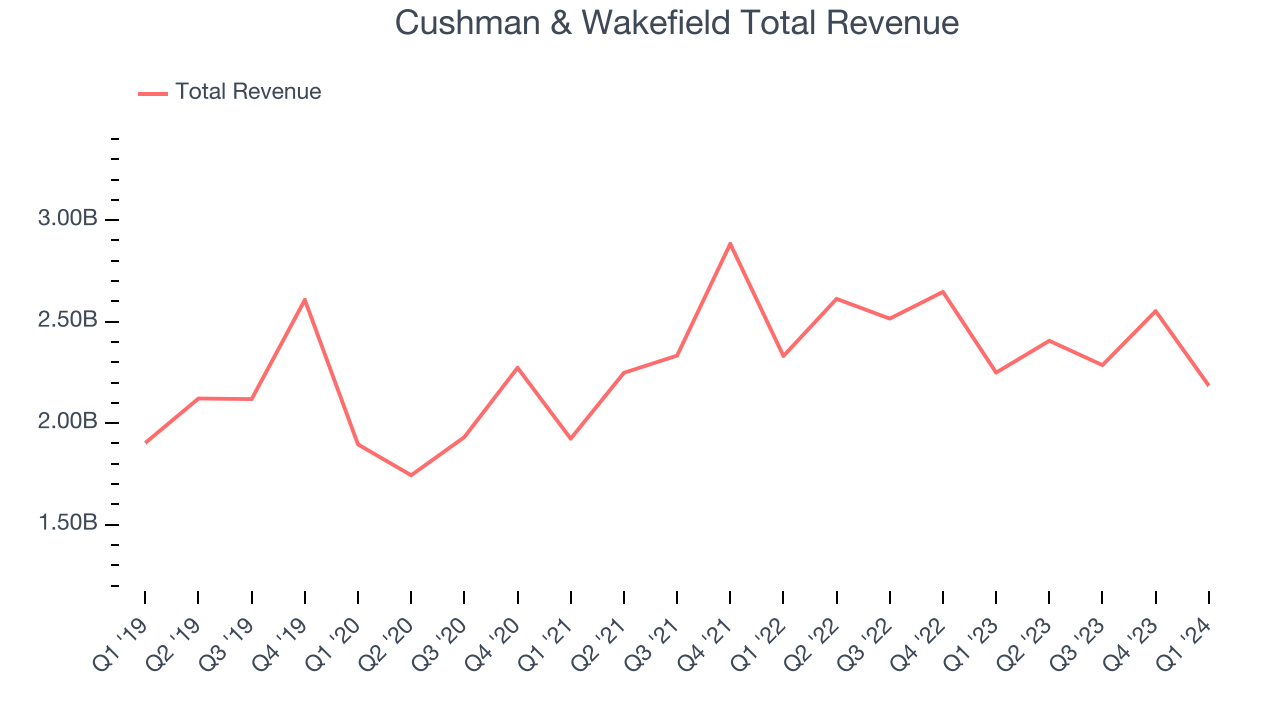 Within consumer discretionary, a long-term historical view may miss a company riding a successful new product or emerging trend. That's why we also follow short-term performance. Cushman & Wakefield's recent history shows a reversal from its already weak five-year trend as its revenue has shown annualized declines of 1.9% over the last two years.
Within consumer discretionary, a long-term historical view may miss a company riding a successful new product or emerging trend. That's why we also follow short-term performance. Cushman & Wakefield's recent history shows a reversal from its already weak five-year trend as its revenue has shown annualized declines of 1.9% over the last two years.
We can better understand the company's revenue dynamics by analyzing its three most important segments: Management, Leasing, and Capital Markets, which are 39.9%, 17.5%, and 6.5% of revenue. Over the last two years, Cushman & Wakefield's Management revenue (property management) averaged 4.5% year-on-year growth while its Leasing (sourcing tenants) and Capital Markets (financial advisory) revenues averaged declines of 3% and 25.8%.
This quarter, Cushman & Wakefield reported a rather uninspiring 2.9% year-on-year revenue decline to $2.18 billion of revenue, in line with Wall Street's estimates. Looking ahead, Wall Street expects sales to grow 3.4% over the next 12 months, an acceleration from this quarter.
Operating Margin
Operating margin is a key measure of profitability. Think of it as net income–the bottom line–excluding the impact of taxes and interest on debt, which are less connected to business fundamentals.
Cushman & Wakefield was profitable over the last two years but held back by its large expense base. Its average operating margin of 3.2% has been paltry for a consumer discretionary business.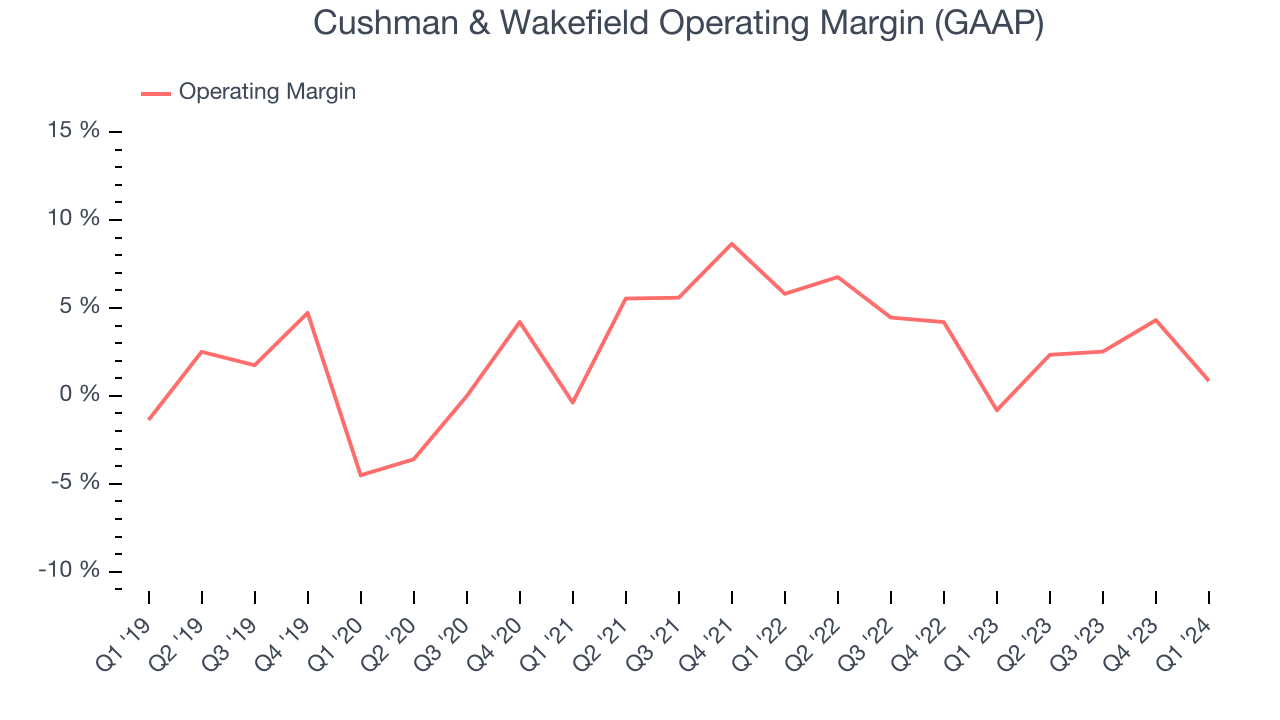
This quarter, Cushman & Wakefield generated an operating profit margin of 0.9%, up 1.7 percentage points year on year.
Over the next 12 months, Wall Street expects Cushman & Wakefield to become more profitable. Analysts are expecting the company’s LTM operating margin of 2.6% to rise to 4.4%.EPS
We track long-term historical earnings per share (EPS) growth for the same reason as long-term revenue growth. Compared to revenue, however, EPS highlights whether a company's growth was profitable. 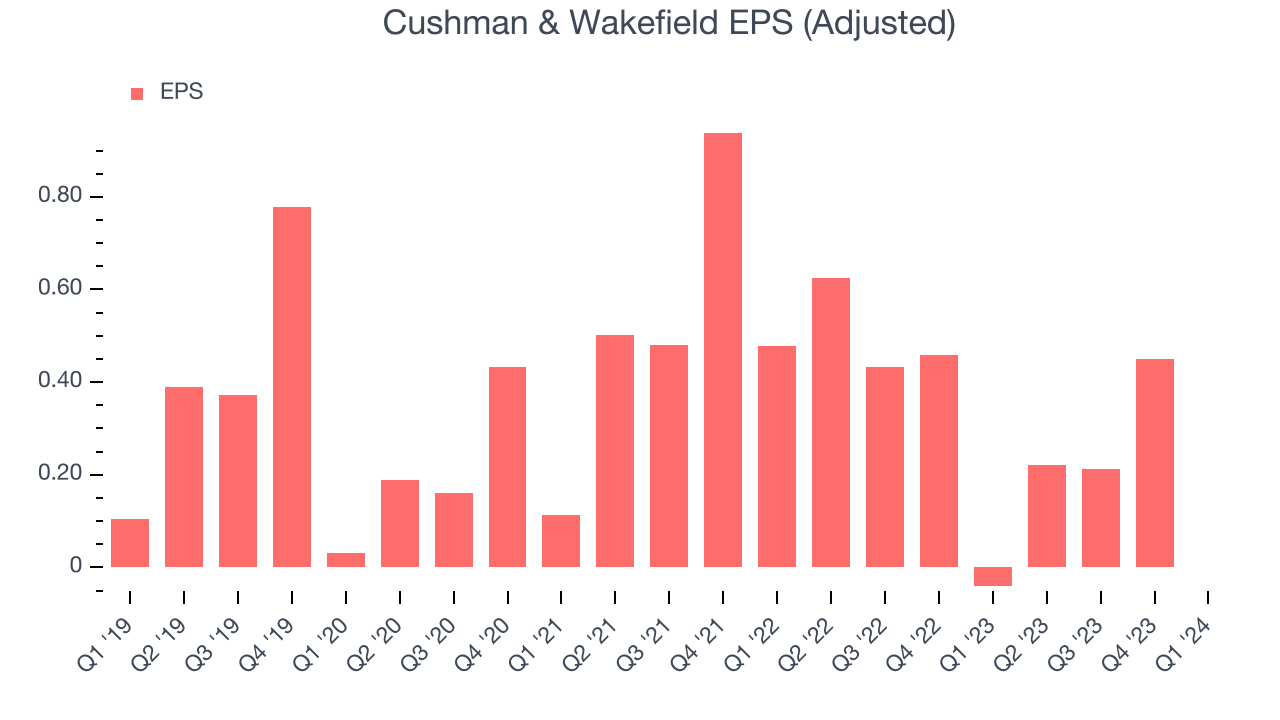
Over the last five years, Cushman & Wakefield's EPS dropped 70.4%, translating into 11.2% annualized declines. We tend to steer our readers away from companies with falling EPS, where diminishing earnings could imply changing secular trends or consumer preferences. Consumer discretionary companies are particularly exposed to this, leaving a low margin of safety around the company (making the stock susceptible to large downward swings).
In Q1, Cushman & Wakefield reported EPS at $0, up from negative $0.04 in the same quarter last year. This print beat analysts' estimates by 100%. Over the next 12 months, Wall Street expects Cushman & Wakefield to grow its earnings. Analysts are projecting its LTM EPS of $0.88 to climb by 19.3% to $1.05.
Cash Is King
Although earnings are undoubtedly valuable for assessing company performance, we believe cash is king because you can't use accounting profits to pay the bills.
Over the last two years, Cushman & Wakefield broke even from a free cash flow perspective, subpar for a consumer discretionary business.
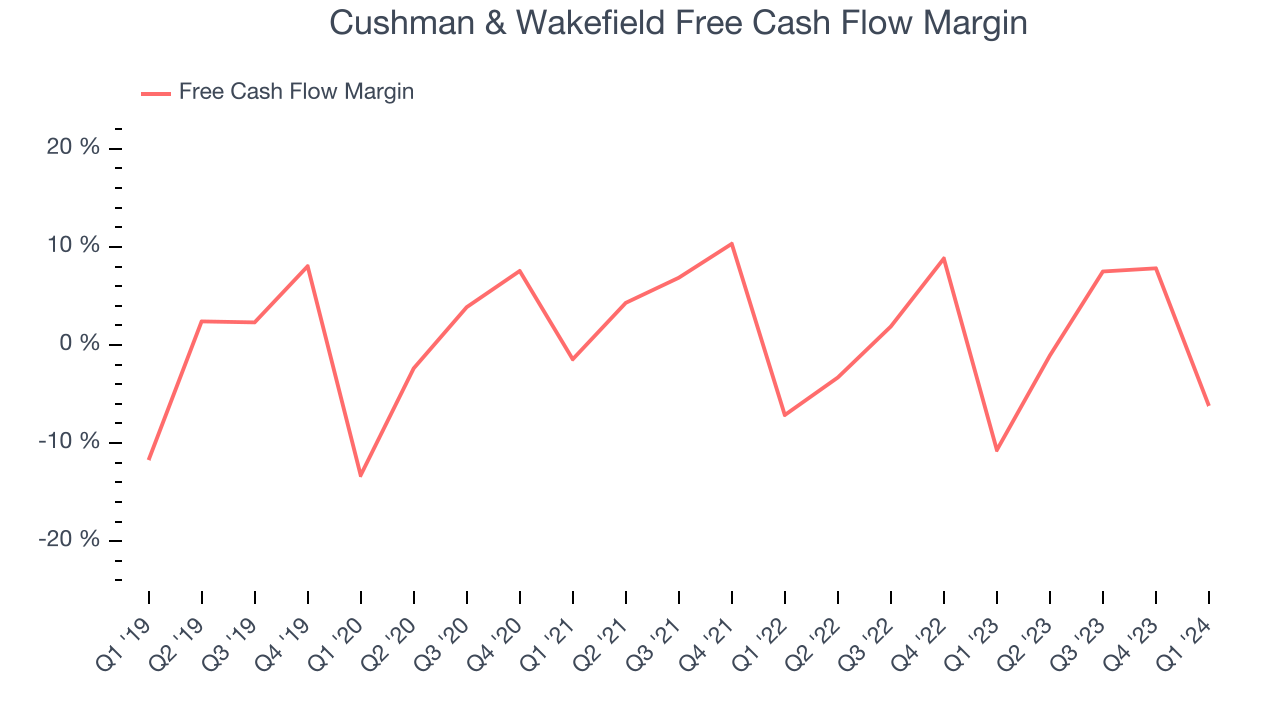
Cushman & Wakefield burned through $135.6 million of cash in Q1, equivalent to a negative 6.2% margin, increasing its cash burn by 43.7% year on year.
Return on Invested Capital (ROIC)
EPS and free cash flow tell us whether a company was profitable while growing revenue. But was it capital-efficient? A company’s ROIC explains this by showing how much operating profit a company makes compared to how much money the business raised (debt and equity).
Cushman & Wakefield's five-year average return on invested capital was 5.2%, somewhat low compared to the best consumer discretionary companies that pump out 25%+. Its returns suggest it historically did a subpar job investing in profitable business initiatives.
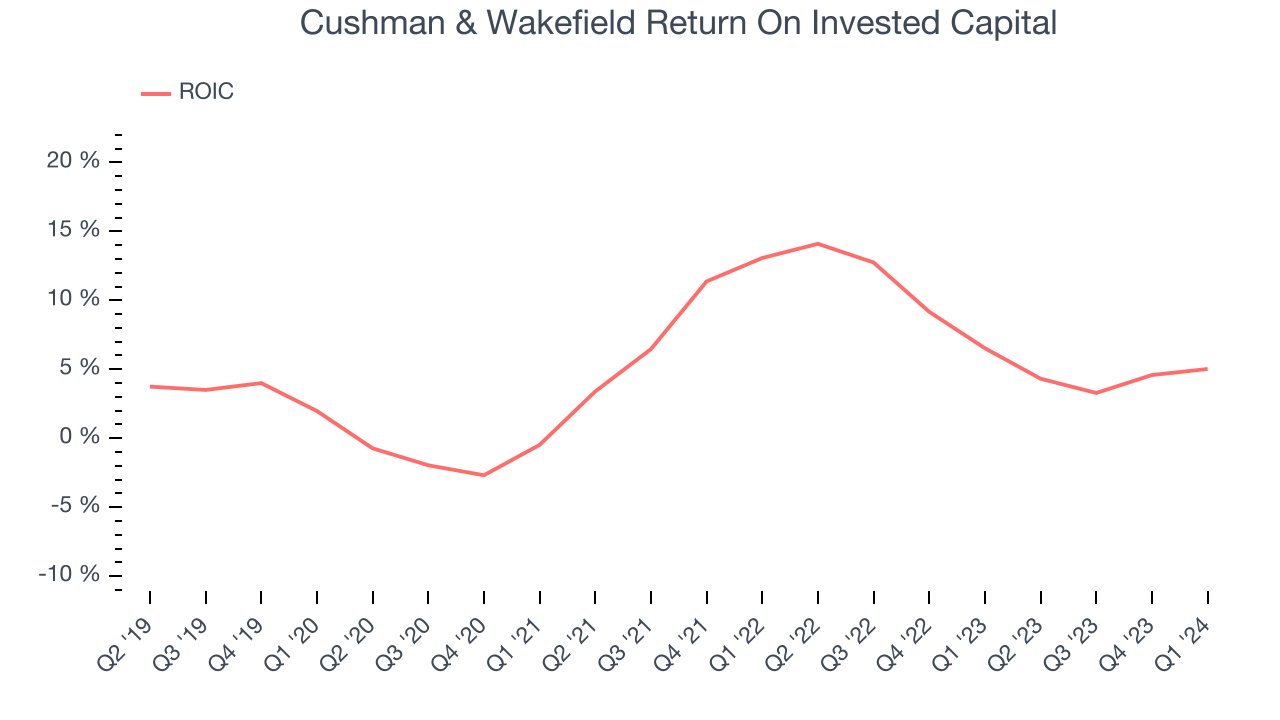
The trend in its ROIC, however, is often what surprises the market and drives the stock price. Over the last few years, Cushman & Wakefield's ROIC averaged 5 percentage point increases. This is a good sign, and we hope the company can continue improving.
Balance Sheet Risk
As long-term investors, the risk we care most about is the permanent loss of capital. This can happen when a company goes bankrupt or raises money from a disadvantaged position and is separate from short-term stock price volatility, which we are much less bothered by.
Cushman & Wakefield reported $553.5 million of cash and $3.49 billion of debt on its balance sheet in the most recent quarter. As investors in high-quality companies, we primarily focus on two things: 1) that a company's debt level isn't too high and 2) that its interest payments are not excessively burdening the business.
With $587.3 million of EBITDA over the last 12 months, we view Cushman & Wakefield's 5.0x net-debt-to-EBITDA ratio as safe. We also see its $212.4 million of annual interest expenses as appropriate. The company's profits give it plenty of breathing room, allowing it to continue investing in new initiatives.
Key Takeaways from Cushman & Wakefield's Q1 Results
It was good to see Cushman & Wakefield beat analysts' revenue, EPS, and EBITDA expectations this quarter, driven by better-than-expected performance in its capital markets segment. The company also restructured $1 billion of debt, which is projected to save $6 million annually. Overall, this quarter's results seemed fairly positive. The stock is flat after reporting and currently trades at $9.91 per share.
Is Now The Time?
Cushman & Wakefield may have had a favorable quarter, but investors should also consider its valuation and business qualities when assessing the investment opportunity.
We cheer for all companies serving consumers, but in the case of Cushman & Wakefield, we'll be cheering from the sidelines. Its revenue growth has been weak over the last five years, but at least growth is expected to increase in the short term. And while its projected EPS for the next year implies the company's fundamentals will improve, the downside is its declining EPS over the last five years makes it hard to trust. On top of that, its relatively low ROIC suggests it has historically struggled to find compelling business opportunities.
Cushman & Wakefield's price-to-earnings ratio based on the next 12 months is 9.4x. While there are some things to like about Cushman & Wakefield and its valuation is reasonable, we think there are better opportunities elsewhere in the market right now.
Wall Street analysts covering the company had a one-year price target of $12.29 per share right before these results (compared to the current share price of $9.91).
To get the best start with StockStory, check out our most recent stock picks, and then sign up for our earnings alerts by adding companies to your watchlist here. We typically have the quarterly earnings results analyzed within seconds of the data being released, and especially for companies reporting pre-market, this often gives investors the chance to react to the results before the market has fully absorbed the information.
